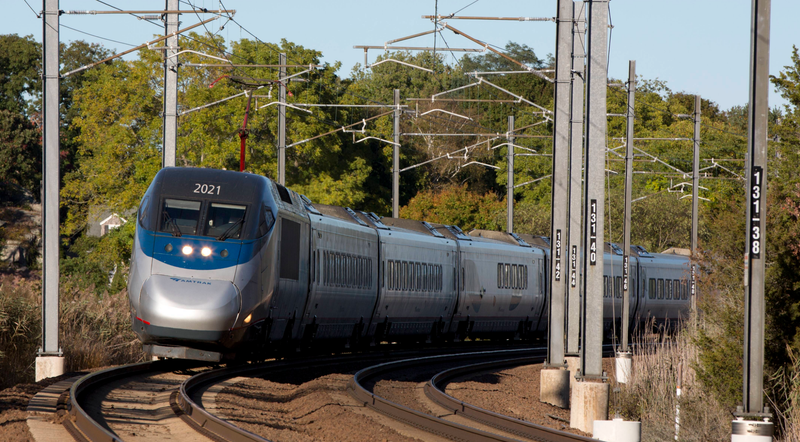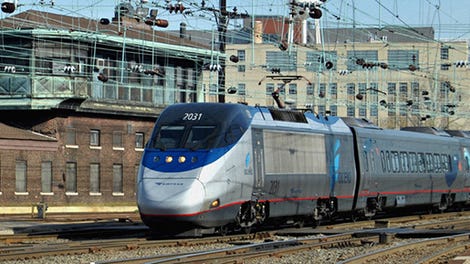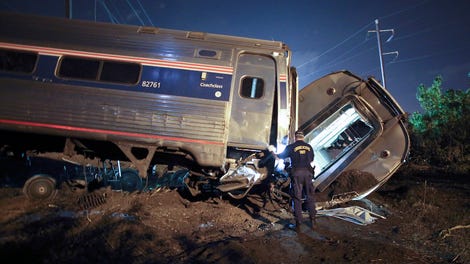
This may not surprise anyone, but with the incoming administration looking to implement “dramatic” cuts to federal spending, one budget blueprint calls for for federal subsidies for Amtrak to be slashed. Here’s why that’s a bad idea.
Advertisement
The Hill reports a coming budget proposal budget proposal hews “closely to a blueprint” from the Heritage Foundation, the influential conservative think tank. At first, it’s not exactly clear which Heritage blueprint The Hill is referencing—one published last February called for eliminating Amtrak’s operating subsidies, as well as the National Endowment for the Arts altogether; another, Blueprint for a New Administration, was published just days before the November presidential election.
But if The Hills’s report is accurate, the earlier blueprint mirrors what’s in the piece and is probably what President Donald Trump’s budget proposal is based off of. (Two members of Trump’s transition team are reportedly orchestrating the austere budget, and both worked for the Heritage Foundation.)
Advertisement
Here is what that document recommends for Amtrak:
Eliminate the federal operating subsidy and phase out the capital programs over five years. This proposal saves $519 million in FY 2017.
Now, Amtrak sucks. Everyone knows that. Anyone who has taken a train in, say, Europe, knows that, comparatively, Amtrak runs a lousy, expensive service—but that doesn’t negate the public good that’s served by subsidizing transit. Removing cars from the road is a benefit to the environment, and it frees up roads for people who actually want to drive. (Ironically, easing congestion is also a purported goal of libertarian-backed endeavors like Uber.)
Allowing people to travel efficiently without a car if they so choose lets them avoid the stress of a jam-packed rush hour. It reduces monthly expenses. I’m in the process of moving from Detroit to New York City, where I’ll no longer have a vehicle. Relying on the city’s subway and bus system will save me an additional $325 per month. (Of course, I know, I’ll be spending that on extra sales tax, or whatever. Still, it helps.)
Sponsored
Yet the Heritage blueprint bleats about Amtrak as being “characterized by an unsustainable financial situation,” but the fact is: All of public transit is fundamentally unsustainable without government aid. A bus or train system can’t operate solely on rider fares alone. It is a myth.
But when it comes to Amtrak, as we’ve previously noted, its problems are the fault of our own. This cut from a National Journalpiece on the company says enough:
Advertisement
Advertisement
In November 2011, Robert Dove, a managing director at the Carlyle Group, the D.C.-based asset-management firm, delivered a presentation to the annual meeting of the U.S. High Speed Rail Association (USHSR), a lobbying-cum-cheerleading group formed shortly after Obama’s election. Dove began his slide show with the usual embarrassing stats about America’s high-speed-rail ineptitude (290 million annual high-speed-rail passengers in Japan; 3 million in America). He went on to estimate that for the Northeast Corridor alone to facilitate legitimate bullet-train travel, up to $117 billion in improvements were necessary. (Amtrak itself, in a 2012 plan that will probably never come to fruition—New York to Boston in 94 minutes!—put the number at $151 billion.) “You will not find the private sector willing to come in at the construction stage or the development stage,” he warned. For that, the government would have to pick up the tab. Only at that point would you “find people like me very, very willing to come in and buy it.” In other words, to get to the conservative dream of a privatized Amtrak, you would first have to pursue the liberal path of spending a massive amount of public money.
That doesn’t even seem to be what Heritage wants. At its core, what the foundation seems to be arguing is that government simply shouldn’t support public transit. You see that view in knee-jerk responses from conservative lawmakers to cut funding to Amtrak just one day after a train crash that left several dead. But the logical conclusion to the idea that government shouldn’t subsidize transit is that it shouldn’t support the construction of roads and bridges—or any infrastructure at all. Who knows: maybe that’s the road it wants the U.S. to go down.
This isn’t the best example for having public transit around, but it’s one that I think helps illustrate the benefits of a connected train system. I recently traveled to NYC to find an apartment, and it happened to be on a weekend when the city was hit with several inches of snow. My flight was canceled. But I had to get back home to cover the Detroit Auto Show. When American Airlines customer service called, they said there was a flight out of Philadelphia I could jump on. So, the next morning, I woke up a couple hours earlier than I would’ve for the NYC flight, took a $55 Amtrak ride to Philadelphia, took a connecting trip to the airport via the local rail authority, and had a nice flight home that had me in place to cover the auto show Monday morning.
Advertisement
Renting a car to get to Philly, along with gas, would’ve cost double, if not triple. That is a small, yet easily digestible, example of why public transit can serve a greater good. And it’s not like my travels were specific only to the northeast corridor, which isn’t as far-flung as, say Montana. I would’ve had the same access to buses or trains if I was stuck in Milwaukee or Minneapolis and had to catch a flight out of O’Hare.
For what it’s worth, Amtrak wasn’t interested in coming on strong in response to what The Hill reported. A spokesperson told me: “The new administration hasn’t submitted a budget, [so] it’s premature to discuss funding.”
What makes something sustainable anyway, in the eyes of Heritage? The government appropriates over $40 billion for highway and bridge improvements—effectively a subsidy for people who drive cars—and that’s not exactly up to snuff, either. How much do we spend on public transit? About half that amount.
Advertisement
Advertisement
Maybe it’s futile to talk about sustainability when the incoming administration has all but written off the effects of human-driven climate change, but what’s the alternative to eliminating services like Amtrak? Putting thousands of more cars on already congested road? That—with increased wear and tear on roads we already don’t spend enough on—isn’t sustainable. It’s sure as hell not what car drivers want, either.
That’s what we’re looking at, though, if this blueprint is proffered by Trump as his budget proposal. Heritage calls for Congress to eliminate Amtrak’s operating subsidies “immediately,” and phase out its capital subsidies over five years “to give Amtrak’s management time to modify business plans, work more closely with the private sector, reduce labor costs, change its marketing, and eliminate any money-losing lines.”
This grossly understates the impact of eliminating Amtrak’s operating funds. As Politiconoted at the time the foundation released its blueprint last February: “Amtrak would ultimately lose its federal subsidies, likely ending the railroad service.” And if I had to guess, Heritage probably knows this.
















